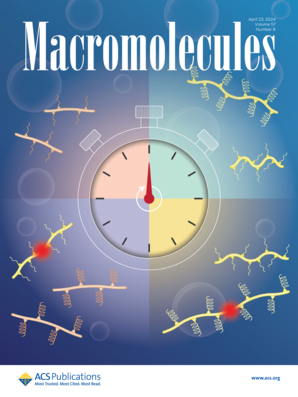弹性体纳米复合材料大变形下纳米力学行为的原位解译方法
IF 5.1
1区 化学
Q1 POLYMER SCIENCE
引用次数: 0
摘要
橡胶和水凝胶等弹性体的力学性能优化和应用范围的扩大一直是材料科学研究的焦点。本文研究了弹性体纳米复合材料在大应变下的力学行为和变形机理,重点研究了炭黑(CB)和碳纳米管(CNT)等纳米填料的增强作用。采用基于原子力显微镜(AFM)的纳米级可视化方法,结合微精密控制单轴拉伸装置,实现了200%应变范围内微观变形行为和应力分布的原位跟踪。研究表明,纳米填料的种类和形态不同,纳米复合材料中的应力传递和分布机制也有显著差异。炭黑复合材料在应变作用下形成应力链,与炭黑填料相互作用形成应力网络结构,从而显著增强。相比之下,碳纳米管复合材料由于其高纵横比和取向行为而表现出不同的机制。这些发现为设计具有定制机械性能的纳米复合橡胶材料提供了重要见解,有助于生物传感器、碳中和技术和航空航天工程的进步。本文章由计算机程序翻译,如有差异,请以英文原文为准。

An In Situ Method for Deciphering Nanomechanical Behavior in Elastomer Nanocomposites under Large Deformation
The optimization of mechanical properties and the expansion of applications for elastomers such as rubber and hydrogels have been longstanding focal points in materials science research. This study investigates the mechanical behavior and deformation mechanisms of elastomer nanocomposites under large strains, focusing on the reinforcing effect of nanofillers such as carbon black (CB) and carbon nanotube (CNT). Using a nanoscale visualization method based on atomic force microscopy (AFM) integrated with a microprecision-controlled uniaxial tensile device, we achieved in situ tracking of microscopic deformation behavior and stress distribution within a 200% strain range. The study reveals that the stress transmission and distribution mechanisms in nanocomposites vary significantly with the type and morphology of the nanofillers. CB composites form stress chains under strain, which interact with CB fillers to create a stress network structure, leading to significant reinforcement. In contrast, CNT composites exhibit a different mechanism due to their high aspect ratio and orientation behavior. These findings provide crucial insights into the design of nanocomposite rubber materials with tailored mechanical properties, contributing to advancements in biosensors, carbon-neutral technologies, and aerospace engineering.
求助全文
通过发布文献求助,成功后即可免费获取论文全文。
去求助
来源期刊

Macromolecules
工程技术-高分子科学
CiteScore
9.30
自引率
16.40%
发文量
942
审稿时长
2 months
期刊介绍:
Macromolecules publishes original, fundamental, and impactful research on all aspects of polymer science. Topics of interest include synthesis (e.g., controlled polymerizations, polymerization catalysis, post polymerization modification, new monomer structures and polymer architectures, and polymerization mechanisms/kinetics analysis); phase behavior, thermodynamics, dynamic, and ordering/disordering phenomena (e.g., self-assembly, gelation, crystallization, solution/melt/solid-state characteristics); structure and properties (e.g., mechanical and rheological properties, surface/interfacial characteristics, electronic and transport properties); new state of the art characterization (e.g., spectroscopy, scattering, microscopy, rheology), simulation (e.g., Monte Carlo, molecular dynamics, multi-scale/coarse-grained modeling), and theoretical methods. Renewable/sustainable polymers, polymer networks, responsive polymers, electro-, magneto- and opto-active macromolecules, inorganic polymers, charge-transporting polymers (ion-containing, semiconducting, and conducting), nanostructured polymers, and polymer composites are also of interest. Typical papers published in Macromolecules showcase important and innovative concepts, experimental methods/observations, and theoretical/computational approaches that demonstrate a fundamental advance in the understanding of polymers.
 求助内容:
求助内容: 应助结果提醒方式:
应助结果提醒方式:


